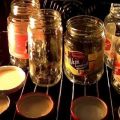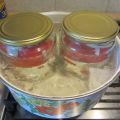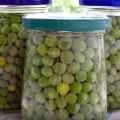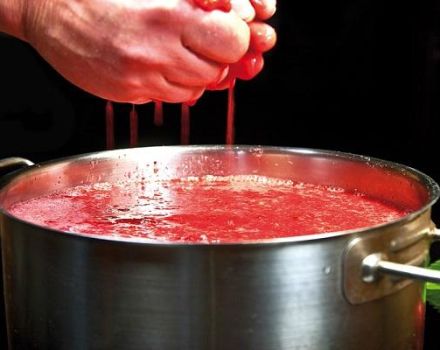How to properly sterilize jars in a pot of water before canning
The question of how to properly sterilize cans steamed or in a pot of water worries many housewives. Violation of the technology can lead to disastrous consequences - the container will crack or the can with conservation will explode. Compliance with all the rules, preliminary inspection of the cans will help to avoid this. There are several ways to sterilize, consider the simplest and tell you about all the intricacies and nuances of the procedure.
Why is sterilization necessary?
When creating conservation, it is important to avoid the ingress of pathogens into the container - they can cause the fermentation process, spoil the workpiece. For this reason, it is so important to boil the jar, following all the recommendations.
Why sterilization is necessary:
- This procedure will help to avoid food spoilage.
- Eliminates the entry of pathogens into the bank.
- The workpiece will not begin to "ferment" and the can will not explode if sterilized correctly.
Reference: sterile containers help to keep the snack longer, avoid untimely spoilage and prevent taste changes.
The main purpose of sterilization is to kill bacteria, to make the container sterile, which will help keep food intact, using certain preservatives.
It will be necessary to sterilize not only the cans, but also the lids, otherwise it will hardly be possible to achieve the desired result.
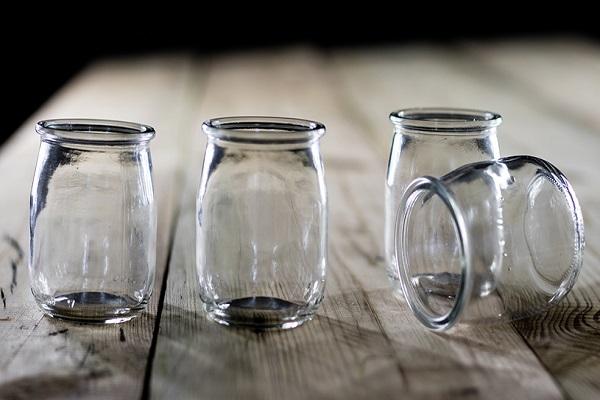
Pot selection
Carrying out all the necessary procedures before canning helps to avoid problems with the workpieces. If you decide to sterilize in a saucepan, then choose it correctly, observing the following recommendations:
- jars must fit completely into the pan, they can be placed or laid horizontally;
- Choose a container with a flat bottom that will heat up evenly.
When creating preservation, they often use half-liter cans, they are successfully placed in a medium-sized pan. Preference is given to enameled cookware, as it heats up evenly and excludes sudden temperature changes.
Before using the purchased pan, wash it thoroughly with baking soda, rinse it with warm water and dry it with a towel. This will help to avoid the addition of extraneous odors and tastes.
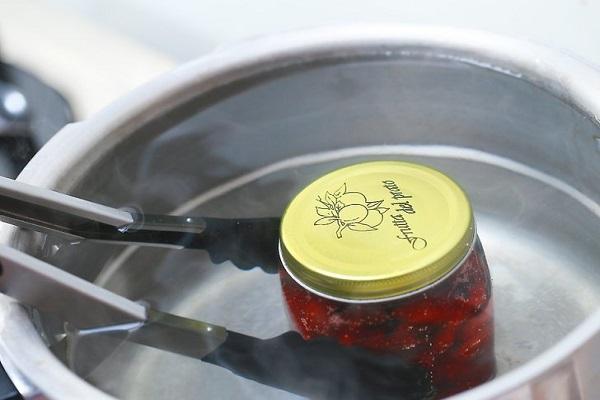
Preparing cans before starting the process
Before boiling, assess the general condition of the container, this will help to avoid problems with preservation in the future:
- It is worth examining the container for cracks, chips and other damage.If any are found, then the jar should be removed, it may burst at the time of sterilization, when the temperature rises or after spinning.
- The container is thoroughly washed under running water, using a new sponge, soda. Powders and liquids are discarded because they can impart an unpleasant chemical odor or off-flavor to the preservation.
- After washing, you should dry the jars, put them upside down, on a towel or paper napkin. And when the last droplets run down the glass, you can start sterilizing the container.
- Pay attention not only to the cans, but also to the lids. There should be an elastic band between them if the caps are twisted. This will ensure the tightness of the conservation.
- The lids will have to be boiled along with the rubber bands, but this will take less time, an average of 1.5 minutes. This will be enough to kill pathogens.
- It is not enough just to pour boiling water over the container; it is necessary to carefully process the cans, maintaining certain temperatures.
- Do not rinse the container with cold water after boiling - a sharp temperature drop is unlikely to be useful for glass containers.
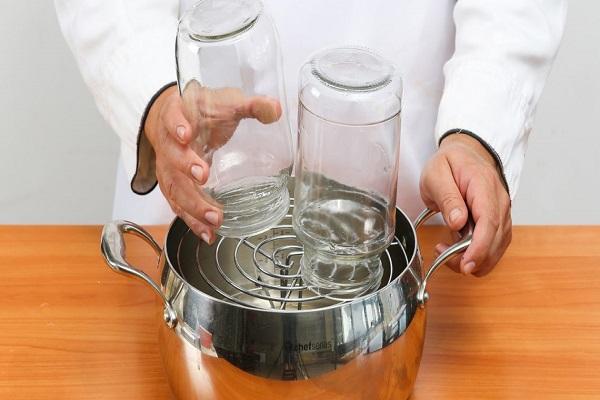
How to properly boil a container in a saucepan
A similar method of sterilizing containers, literally on the stove, is carried out in stages. You will have to do the following:
- Rinse and dry the jars, then place them on the bottom of the pan, after placing parchment or a clean cloth there.
- It is worth pouring water into the pan so that the liquid completely covers the container, turn on the stove, bring the water to a boil. For 5-7 minutes it is worth boiling the containers without removing them from the pan.
- Contact with boiling water for the specified time will help kill the disease-causing bacteria. After that, it is worth removing the container from the water, wiping it and placing it upside down so that the drops drip. After a couple of minutes, you can lay out salads, pickles and preserves in containers.
- If the jars are not completely covered with water, microbes may remain on their surface. Don't forget to boil the lids too.
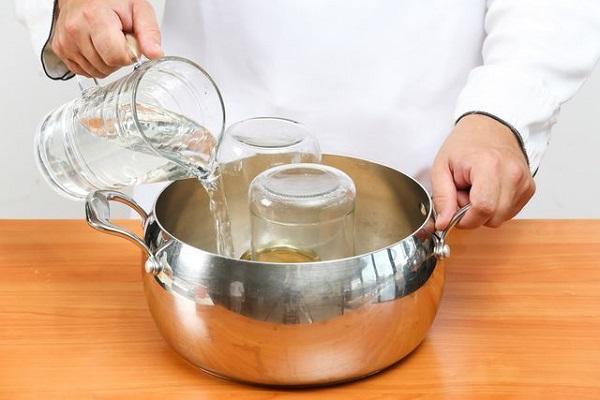
Steam sterilization at home
To carry out such a procedure, you should follow the recommendations:
- Choose a container; You can use a shallow pan, the wider it is, the better - more cans will fit.
- A metal grate is also used. In general, this is all that is required for the procedure.
- Pour water into a saucepan, then bring it to a boil. We place a metal grate on top, put the container upside down on it.
- During the steam treatment, condensation will accumulate on the walls of the can and on the bottom. As soon as these drops "wash" the entire container, we can say that the sterilization is complete.
- Using a potholder, the jar is removed from the grate, in the same position, placed on a piece of cloth upside down or using a paper towel.
- The duration of sterilization depends on the volume of the container. On average, processing takes 7-10 minutes. Do not be afraid that in a few minutes or hours pathogenic microorganisms will get into the container. Their characteristics, processed according to all the rules, keep the containers for two days.
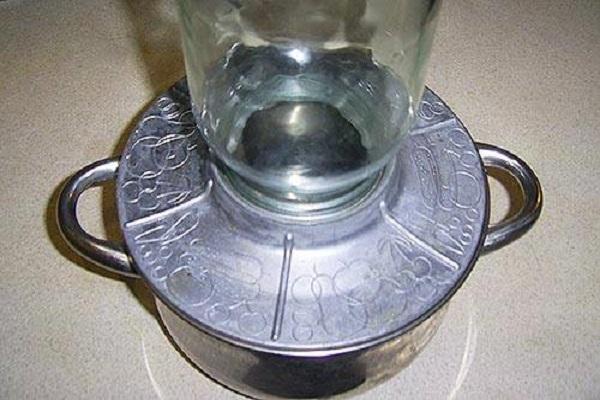
Is it possible to sterilize cans with blanks?
Yes, jars of salad or pickles are also processed in boiling water. This method is well known to experienced housewives.
How to carry out the procedure:
- salad, vegetables or jam are placed in a pre-prepared container, they are not closed with a lid;
- the lid should be boiled, along with the rubber band, prepare it for subsequent procedures;
- the jar, along with the preservation, is placed in water, brought to a boil, kept for 5-10 minutes, as long as possible.
After boiling, the jars are carefully taken out of the pan and placed upside down, covered with a warm towel, "wrapped", having previously closed with a lid.
Attention! Salads are laid out in containers warm or hot - this is a prerequisite.

More often, this method is used to create adjika, lecho, salads and other blanks. During the sterilization process, you will have to make sure that no water gets into the containers. Time depends on the volume of the container; if the container is large, then it will have to be sterilized for half an hour.
In this case, the cans are checked for chips and damage before washing. Unsuitable containers are removed to avoid further problems.
Sterilizing jars correctly is not as difficult as it seems at first glance. If you follow all the recommendations, you will be able to eliminate bacteria, kill them with hot steam or boiling water. A prepared container will help keep the workpiece longer, will not affect its taste characteristics, and will not cause spoilage of salad, seasoning or pickles.




